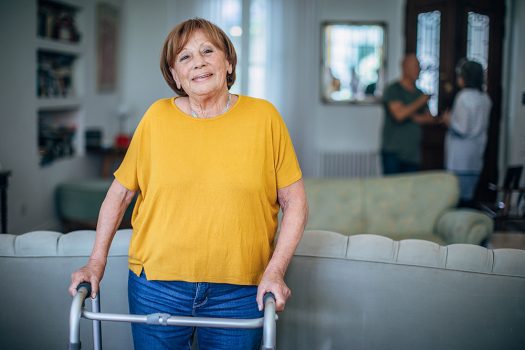 Ability Action Australia provides NDIS therapeutic supports for individuals of all ages. This includes occupational therapy for adults who are older, and who live with disability.
Ability Action Australia provides NDIS therapeutic supports for individuals of all ages. This includes occupational therapy for adults who are older, and who live with disability.
Many older people living with disability want to remain independent for as long as possible so they can stay living in their own home. This in turn allows them to stay connected – with family and friends, their social groups, and their neighbourhood.
Occupational therapists (OTs) often work with older people to make living safely and confidently at home possible. Through education, home modifications, assistive technology, and a whole range of other personalised services and interventions, OTs can help people stay in touch with their communities and improve their physical and mental health and emotional wellbeing as a result.
What support can occupational therapy provide older adults?
OTs can help make life easier for older NDIS participants through a number of therapeutic and educational interventions. To begin with, an OT will perform a functional capacity assessment for participants who are having trouble performing self-care and daily activities around the home. This assessment also looks at how well someone can take part in meaningful community activities.
The assessment will determine the interventions needed to maintain independence, such as:
People living with disability are often the most in need of assistive technology, which can enable them to continue to live at home and delay or prevent the need for long-term care. Assistive technologies include physical equipment such as ramps and stair lifts; mobility aids like wheelchairs, adjustable beds and electric lift chairs; cognitive memory aids; and electronic devices, such as alarms, orientation clocks, smart home device, and smart stove-tops.
The types of modifications available range from the basic, such as grab rails, handrails, lever taps, and mounted shower chairs, to the complex, such as ramps and bathroom and kitchen modifications. Making these changes to homes can have a big impact on how people live their lives, allowing greater flexibility and maximising participant independence and safety.
- Energy conservation techniques
Energy conservation methods are a simple and effective way to minimise muscle fatigue, joint stress, and pain. Rather than completing an activity all at once, the idea is to break it down into smaller, more manageable tasks so that the level of stress on joints is reduced and the body has a chance to recover. It’s also about organising the participant’s schedule through the day to perform more demanding tasks at specific times and making sure they have rest periods if necessary. For instance, one method is to allow dishes to airdry and put them away in the morning, rather than washing up, drying and putting away dishes all at once. Older people can also use a shower chair to save energy while showering, and alternate between heavy and light tasks.
- Falls prevention techniques
Slips, trips, and falls in and around the home are often the cause of injuries to older adults. Usually they’re the result of a combination of factors related to the person, such as muscle weakness or impaired balance, and the environment, such as loose rugs or clutter.
OTs possess the skills needed to help prevent falls in older adults. They will review the home environment for hazards and evaluate their client for limitations that contribute to falls (and remove them if possible), before recommending interventions such as home modifications, and improving physical ability to safely perform daily tasks.
- Compensatory strategies
If an older person’s daily functioning is affected by physical or cognitive difficulties, an OT can provide strategies or techniques that work around their limitations and help people perform tasks in an alternative manner. One example of a physical adaptation is to use a different dressing technique, such as sitting down or using a shoehorn. Other examples include making appointments at the same time of the day, keeping a phone or wallet in the same place when not in use, and using visual aids like a calendar or diary, and picture-based orientation signs. An OT can also modify the environment by removing clutter, and placing bright labels on important buttons on a microwave or a washing machine.
The ability of an older person to drive safely, consistently and independently may be affected by their disability. For instance, people with dementia may get disorientated or lost while driving in familiar areas, or forget the purpose of their trip. A driver trained OT can assess your fitness to drive and help keep you driving for as long as it’s safe to do so. Sometimes people can continue to drive independently as long as they have a condition added to their licence, such as only driving in daylight or in off-peak hours, or driving only in familiar areas within a set radius from home.
What conditions in older people can an OT treat?
Our OTs work with older NDIS participants living with a range of conditions, which can include:
- Neurological/neurodegenerative conditions such as Parkinson’s disease, multiple sclerosis, Alzheimer’s disease, and Lewy body dementia
- Physical disability such as functional decline and frailty, amputees, osteoarthritis
- Psychosocial disabilities such as depression, anxiety, schizophrenia, bipolar disorder and post-traumatic stress disorder
- Intellectual disability
Our practitioners can provide occupational therapy for adults of all ages, whether they live independently or need greater support.
Do OTs work within multidisciplinary teams?
It is essential to work within a multidisciplinary team when working with older adults to provide them with the best care possible. In a typical aged care setting, OTs work alongside clinical staff such as nurses, GPs, physiotherapists, exercise physiologists, psychologists, dieticians and social workers. Additionally, OTs work with healthcare staff who provide direct care to residents, and lifestyle teams who engage residents in recreational activities.
How can older people benefit from seeing an OT?
There are many important benefits from seeing an OT. As an older person you can:
- Live in your own home for longer
- Improve your quality of life with the use of assistive technologies
- Prevent falls through education
- Apply energy conservation techniques to engage in meaningful activities
- Be safer and more independent through adopting simple and complex equipment, such as:
- Manual and electric wheelchairs
- Seating aids such as lift chairs
- Adjustable beds
- Pressure care such as pressure cushions and air mattresses
- Toileting aids to assist with transfers and the process of toileting
- Showering aids including shower chairs and long handled tools
- Orientation devices to assist those with impaired cognition
When it comes to occupational therapy for independent living, older adults who live with disability can receive a number of different therapeutic supports.
Can you provide some examples?
Ability Action Australia works with many older NDIS participants. Below are two recent examples of the work of our OTs in supporting people to live with greater independence and dignity:
- A client with multiple sclerosis wanted to remain living in her home. She required a functional capacity assessment to identify difficulties in her daily life and the supports needed for remaining at home. Our OT provided energy conservation techniques; basic assistive technologies for continence issues and showering needs; compensatory cognitive techniques to improve memory and ability to complete functional tasks such as meal preparation and laundry. The participant is now able to maintain her independence at home.
- A client with dementia was able to achieve her main goal of living in her own home, by following OT recommendations such as: implementing orientation devices to remind her to take her medication; minor modifications such as grab rails to her bathroom, toilet and entrance of her home to reduce risk of falls; engaging support workers to assist with community access and domestic duties; and a personal alarm to ensure she could call for help easily should she need to.
Occupational therapy for adults of all ages
Age should not be a factor in deciding whether you get the support you need to reach your goals. In addition to age-related conditions, we also provide occupational therapy for adults with autism and other lifelong conditions. Our OTs also support children and adolescents with their NDIS goals.
Whether you’re just getting started with an NDIS plan, evaluating your therapy options, or would like to know more about how we can help you reach your goals, call us to speak to our friendly Ability Action Australia concierge service. They’ll be happy to answer any questions to help you in a simple and easy way to implement your plan.
Phone us on 1800 238 958 or email hello@abilityactionaustralia.com.au

